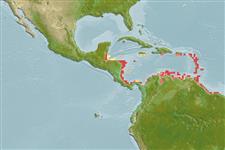Bivalvia |
Cardiida |
Donacidae
Environment: milieu / climate zone / depth range / distribution range
Ecology
Benthic; depth range 0 - 2 m (Ref. 83435). Tropical; 18°N - 6°N, 88°E - 35°E (Ref. 83435)
Western Atlantic: Caribbean and Lower Antilles to northern South America.
Length at first maturity / Size / Weight / Age
Maturity: Lm ? range ? - ? cm Max length : 4.0 cm NG male/unsexed; (Ref. 83435); common length : 2.5 cm TL male/unsexed; (Ref. 344)
Shell wedge-shaped, inflated. Posterior slope flat or concave, with fine radial threads. Colour: variable, usually cream with purplish or bluish tinges. Umbones usually darker hues.
Habitat: Infaunal in shallow sand, usually in environments rich in particulate organic matter (Ref. 344).
Life cycle and mating behavior
Maturity | Reproduction | Spawning | Eggs | Fecundity | Larvae
Members of the class Bivalvia are mostly gonochoric, some are protandric hermaphrodites. Life cycle: Embryos develop into free-swimming trocophore larvae, succeeded by the bivalve veliger, resembling a miniature clam.
Leal, J.H. 2003 Bivalves. p. 25-98. In Carpenter, K.E. (ed.). The living marine resources of the Western Central Atlantic. Volume 1: Introduction, molluscs, crustaceans, hagfishes, sharks, batoid fishes, and chimaeras. FAO Species Identification Guide for Fishery Purposes and American Society of Ichthyologists and Herpetologists Special Publication No. 5. 1600p. (Ref. 344)
IUCN Red List Status
(Ref. 130435: Version 2025-1)
CITES status (Ref. 108899)
Not Evaluated
Not Evaluated
Threat to humans
Harmless
Human uses
Fisheries: commercial
| FishSource |
Tools
More information
Trophic EcologyFood items (preys)
Diet composition
Food consumption
Predators
Life cycleReproductionMaturityFecunditySpawningEggsEgg developmentLarvae PhysiologyOxygen consumption
Human RelatedStamps, coins, misc.
Internet sources
Estimates based on models
Preferred temperature
(Ref.
115969): 27 - 28.4, mean 27.6 (based on 174 cells).
Resilience
High, minimum population doubling time less than 15 months (K=0.8).
Fishing Vulnerability
Low vulnerability (10 of 100).
